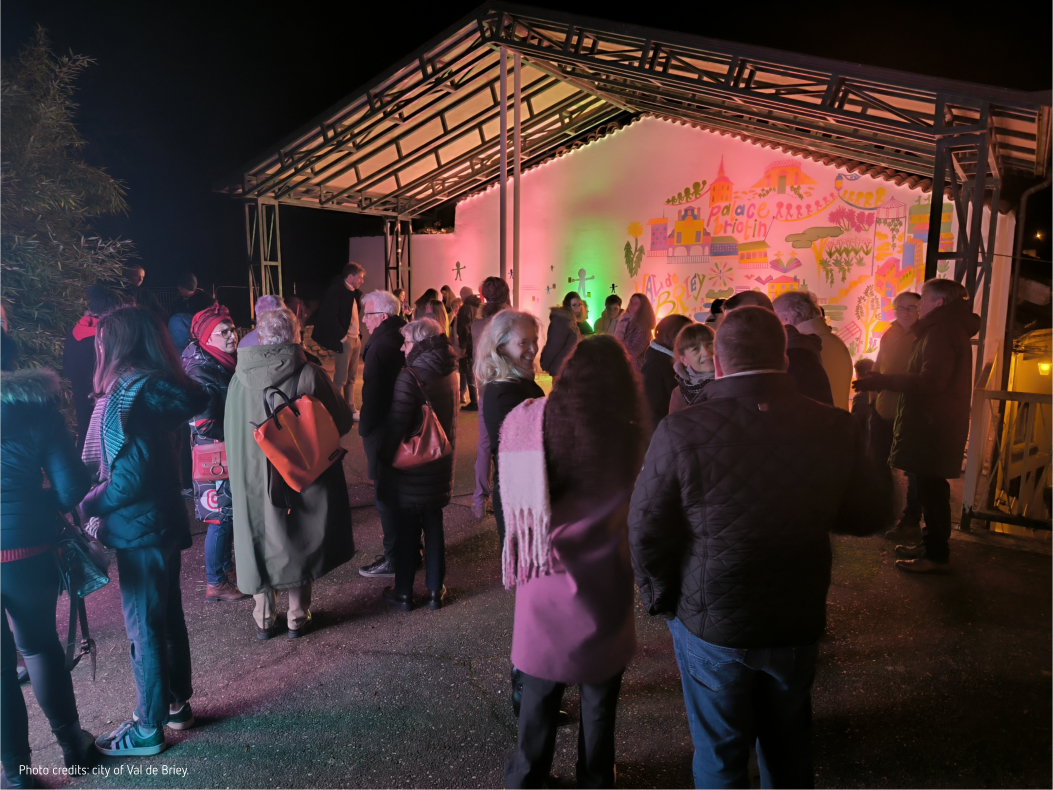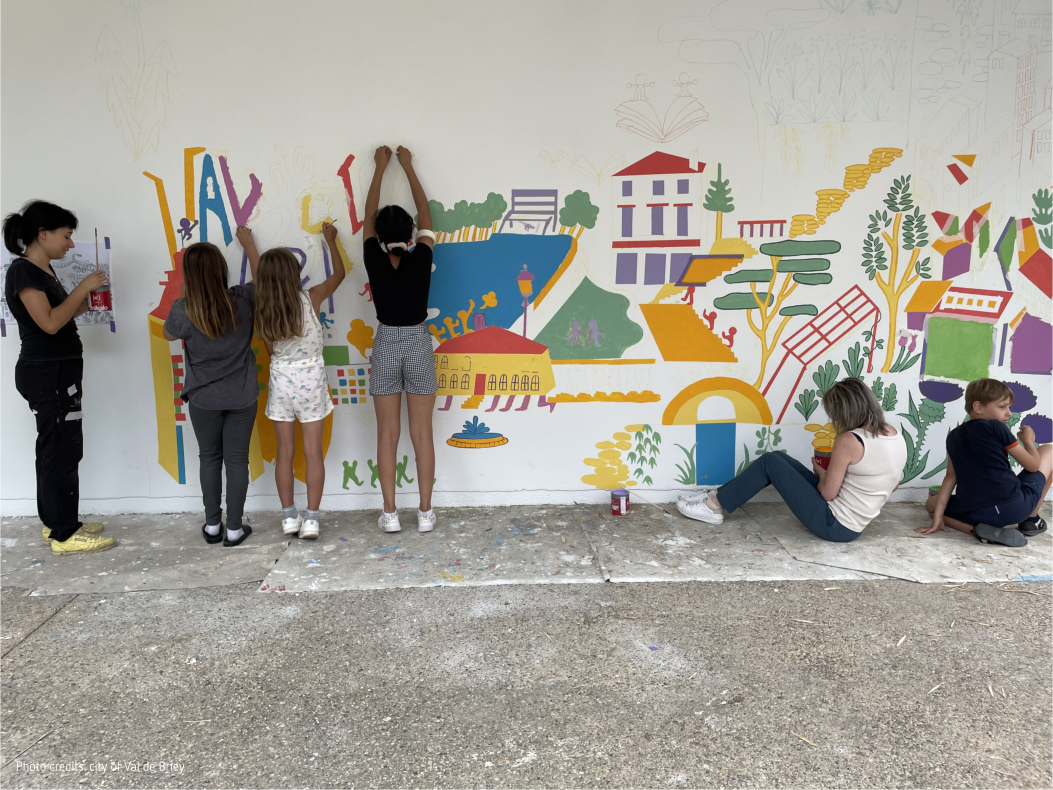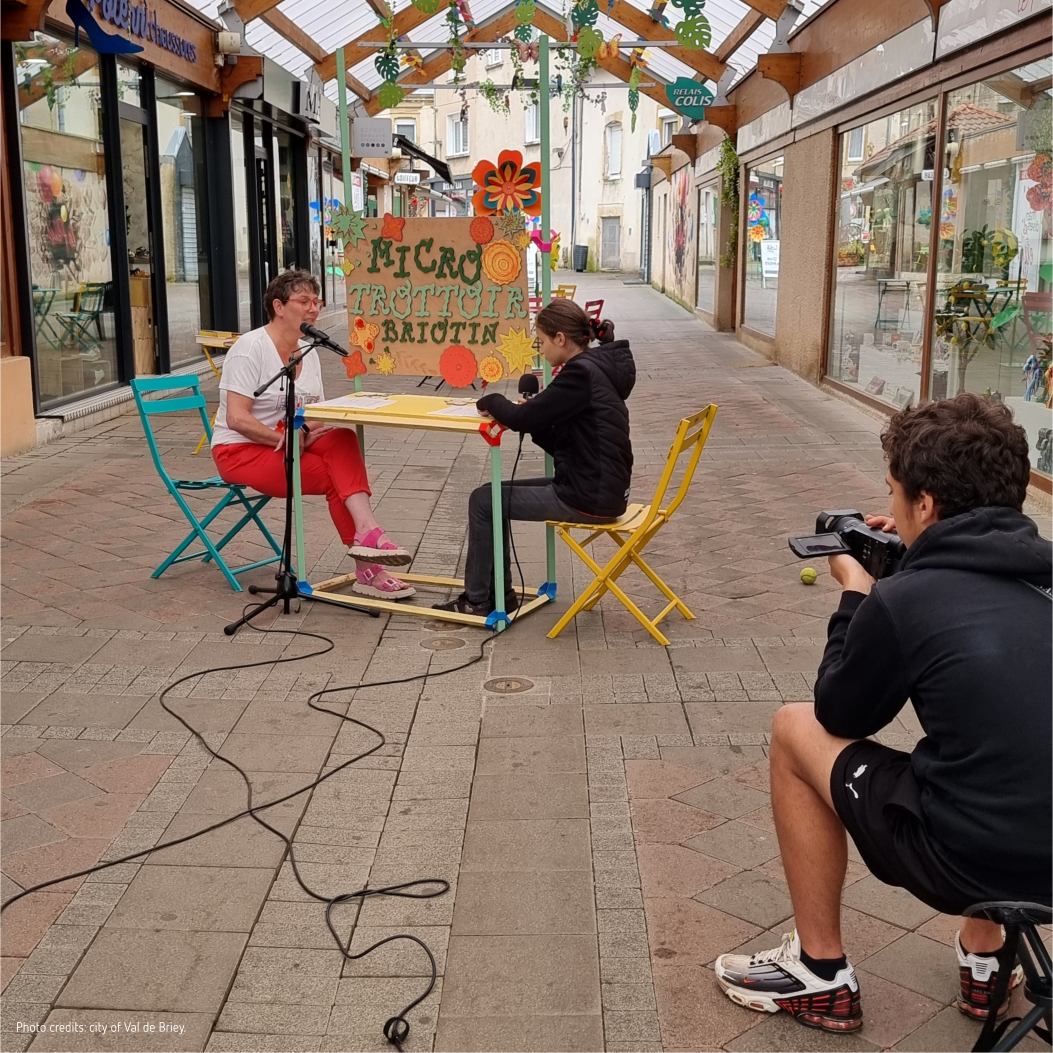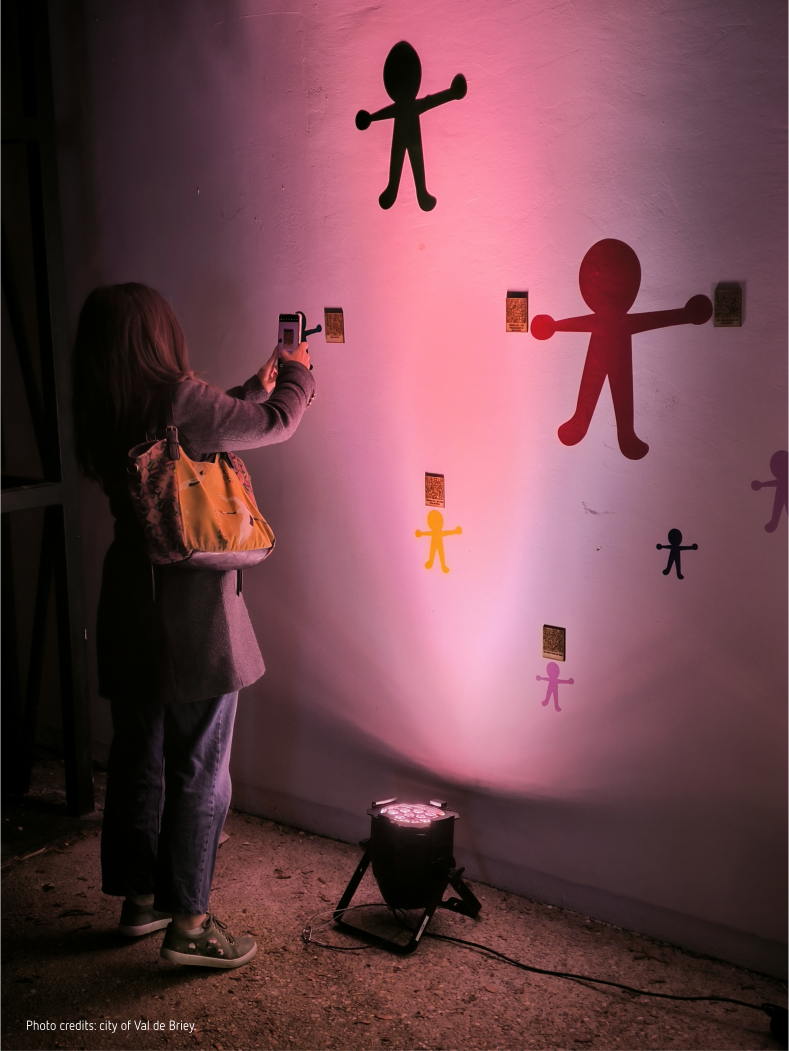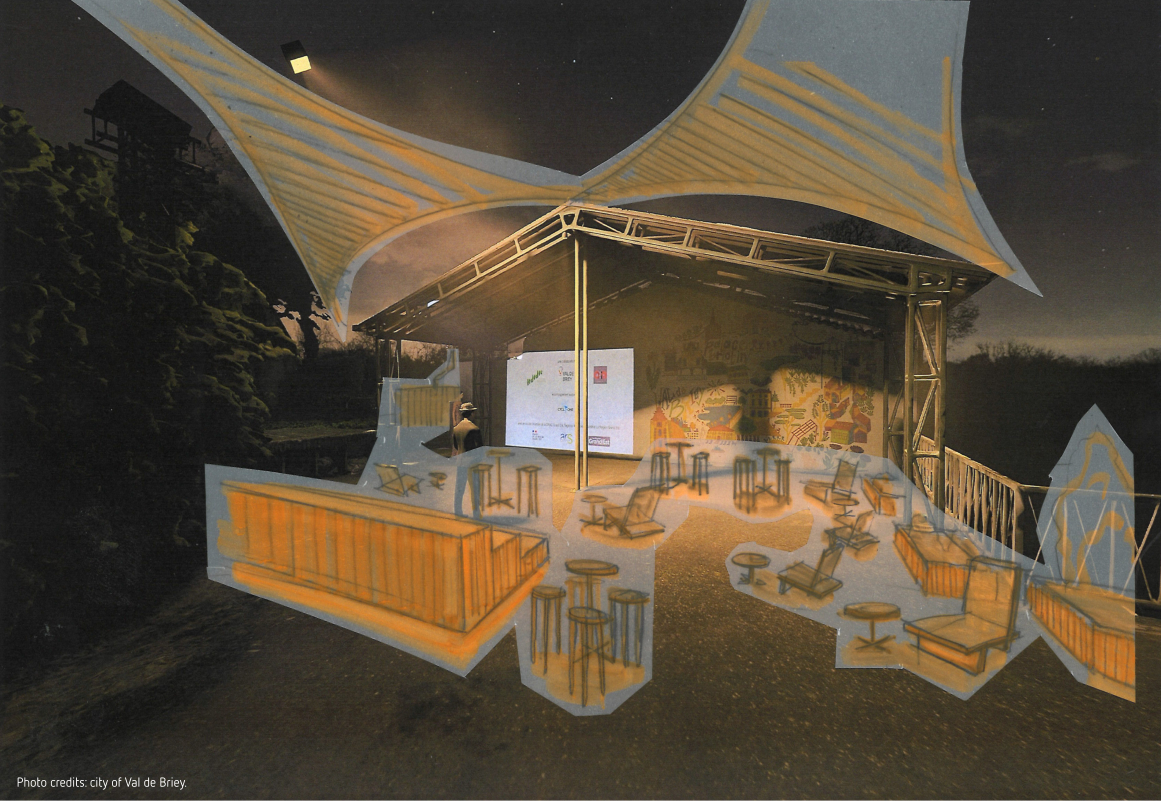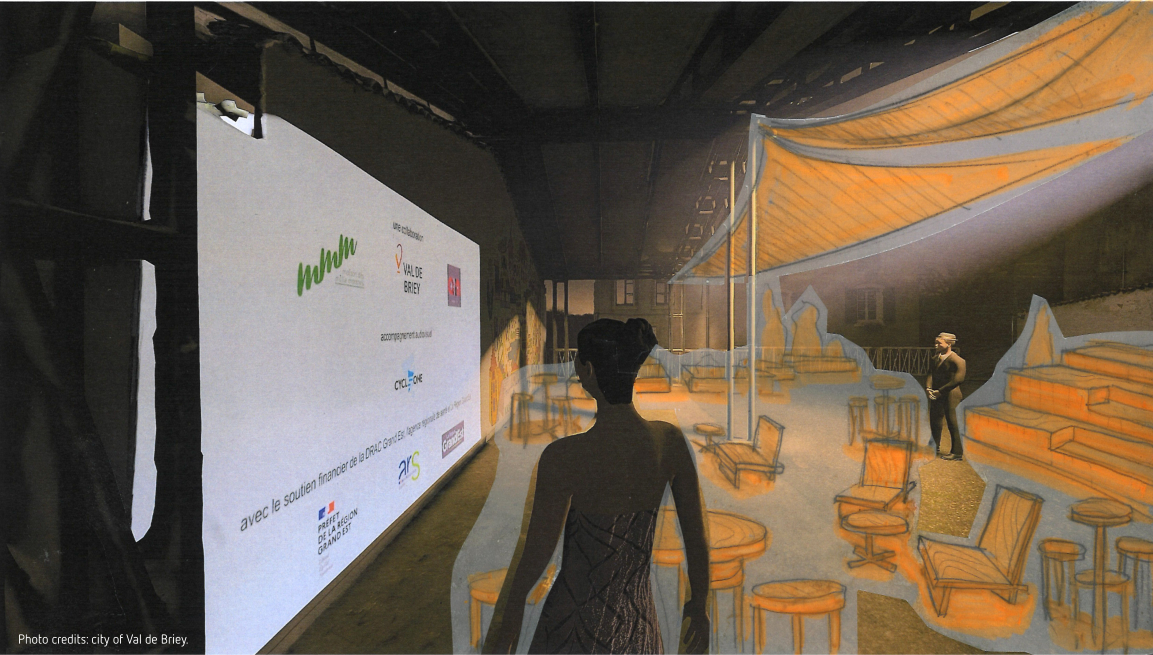Ciné Quartier project
Ciné Quartier project in Val de Briey
The Ciné Quartier project aims to create the first open air autonomous micro-cinema in France, dedicated to short films. This multi disciplinary project gathers art, collective action, eco-citizenship to revitalize a sector of the city of Val de Briey and to bring a new cultural equipment made by and for the inhabitants. It deals with ecological transition, tactical urbanism, senior and disabled inclusion.
Vote for our initiative!
Vote for our initiative!
France
Place de l'hôtel de ville
Prototype level
Yes
Yes
Yes
No
No
54099: Val de Briey (FR)
Ciné Quartier: France’s First Open-Air Micro-Cinema
The Initiative
Ciné Quartier revitalizes Val de Briey’s historic Grand’rue by transforming the former Le Palace Briotin cinema into a cultural and social hub. Supported by the DRAC Grand Est, ARS, and Région Grand Est, the project is part of a broader urban renewal effort aligned with the Petites Villes de Demain program.
Objective
Turn a neglected urban space into a sustainable, innovative cultural site, fostering social cohesion, heritage preservation, and environmental responsibility.
Target Groups
- Direct: Local residents, IME Les Orchidées pupils, nursing home residents, artists.
- Indirect: All Val de Briey inhabitants, tourists, shopkeepers, schools.
Key Goals
- Urban & Cultural Regeneration: Restore a historic site, enhance Grand’rue’s appeal, strengthen city connections.
- Innovation & Sustainability: Install an autonomous projection system, integrate renewable energy, promote circular economy.
- Social Inclusion: Engage residents in design and execution, foster intergenerational collaboration, develop local skills.
Expected Impact
- Cultural: A vibrant, accessible venue, new artistic practices, enhanced district image.
- Environmental: Recycled materials, renewable energy, shared green spaces.
- Technical: Open-source broadcasting system, replicable eco-micro-cinema model.
Implementation
- Phase 1 (2024): Community fresco, sweded films, resident interviews, documentary.
- Phase 2 (2025-2026): Projection system, recycled furniture, solar panels, water recovery, community-led programming.
This pioneering project, rooted in New European Bauhaus values, blends culture, technology, and sustainability to inspire urban renewal.
The Initiative
Ciné Quartier revitalizes Val de Briey’s historic Grand’rue by transforming the former Le Palace Briotin cinema into a cultural and social hub. Supported by the DRAC Grand Est, ARS, and Région Grand Est, the project is part of a broader urban renewal effort aligned with the Petites Villes de Demain program.
Objective
Turn a neglected urban space into a sustainable, innovative cultural site, fostering social cohesion, heritage preservation, and environmental responsibility.
Target Groups
- Direct: Local residents, IME Les Orchidées pupils, nursing home residents, artists.
- Indirect: All Val de Briey inhabitants, tourists, shopkeepers, schools.
Key Goals
- Urban & Cultural Regeneration: Restore a historic site, enhance Grand’rue’s appeal, strengthen city connections.
- Innovation & Sustainability: Install an autonomous projection system, integrate renewable energy, promote circular economy.
- Social Inclusion: Engage residents in design and execution, foster intergenerational collaboration, develop local skills.
Expected Impact
- Cultural: A vibrant, accessible venue, new artistic practices, enhanced district image.
- Environmental: Recycled materials, renewable energy, shared green spaces.
- Technical: Open-source broadcasting system, replicable eco-micro-cinema model.
Implementation
- Phase 1 (2024): Community fresco, sweded films, resident interviews, documentary.
- Phase 2 (2025-2026): Projection system, recycled furniture, solar panels, water recovery, community-led programming.
This pioneering project, rooted in New European Bauhaus values, blends culture, technology, and sustainability to inspire urban renewal.
Revitalisation
Innovation
Sustainability
Participation
Culture
In terms of sustainability, the Ciné Quartier project stands out for its comprehensive environmental approach:
Energy self-sufficiency: Installation of solar panels to power the sound and lighting systems.
Circular economy: Creation of street furniture from recycled materials (particularly wood)
Water management: Installation of a rainwater recovery system
Biodiversity: development of shared green spaces
The exemplary nature of the project is based on the open source documentation of these ecological solutions, enabling them to be reproduced in other urban contexts, in line with the sustainability objectives of the New European Bauhaus.
Energy self-sufficiency: Installation of solar panels to power the sound and lighting systems.
Circular economy: Creation of street furniture from recycled materials (particularly wood)
Water management: Installation of a rainwater recovery system
Biodiversity: development of shared green spaces
The exemplary nature of the project is based on the open source documentation of these ecological solutions, enabling them to be reproduced in other urban contexts, in line with the sustainability objectives of the New European Bauhaus.
In terms of aesthetics and quality of experience, the Ciné Quartier project proposes a multi-dimensional approach:
Design and urban integration:
Sensitive reactivation of a historic cultural site (the former ‘Le Palace Briotin’ cinema)
Creation of an experiential route along the Grand'rue
Harmonious integration of recycled wood street furniture
Artistic installation of shade cloths
Emotional and artistic experience:
Connection to the collective memory via the historical fresco
Artistic creation through the participatory fresco
Creation of an open-air projection space evoking conviviality
Ownership of the space by local residents through their creative participation
Promotion of the initiative through the documentary produced
Participatory signage
Cultural benefits :
Participatory programming involving local inhabitants
Production of ‘swedish’ films to enhance collective creativity
Training in audiovisual tools to develop new skills
Creation of an intergenerational cultural meeting place
The exemplary nature of the project lies in the successful fusion of historical heritage, technological innovation and citizen participation, creating a cultural space that will generate positive emotions while respecting the identity of the site.
Design and urban integration:
Sensitive reactivation of a historic cultural site (the former ‘Le Palace Briotin’ cinema)
Creation of an experiential route along the Grand'rue
Harmonious integration of recycled wood street furniture
Artistic installation of shade cloths
Emotional and artistic experience:
Connection to the collective memory via the historical fresco
Artistic creation through the participatory fresco
Creation of an open-air projection space evoking conviviality
Ownership of the space by local residents through their creative participation
Promotion of the initiative through the documentary produced
Participatory signage
Cultural benefits :
Participatory programming involving local inhabitants
Production of ‘swedish’ films to enhance collective creativity
Training in audiovisual tools to develop new skills
Creation of an intergenerational cultural meeting place
The exemplary nature of the project lies in the successful fusion of historical heritage, technological innovation and citizen participation, creating a cultural space that will generate positive emotions while respecting the identity of the site.
In terms of inclusion, the Ciné Quartier project stands out for its comprehensive approach:
Universal accessibility:
Partnership with the IME (Institut médico-éductif) ‘Les Orchidées’ for the inclusion of people with disabilities
Partnership with EREA (Etablissement régional d'enseignement adapté)
Connection between upper city and lower city to improve physical accessibility
Free events to ensure financial accessibility
Participatory governance:
Programming committee including all social groups
Co-design with inhabitants at every stage
Active collaboration with EHPAD (retirement homes) and adapted educational establishments
Involvement of local associations and residents in the management of the venue
Inclusive design:
Creation of furniture suitable for all ages
Street furniture designed for different uses
The exemplary nature of the project is demonstrated by the creation of a model of participative cultural governance that places inclusion at the heart of the project, encouraging the emergence of new intergenerational and intercultural social links.
Universal accessibility:
Partnership with the IME (Institut médico-éductif) ‘Les Orchidées’ for the inclusion of people with disabilities
Partnership with EREA (Etablissement régional d'enseignement adapté)
Connection between upper city and lower city to improve physical accessibility
Free events to ensure financial accessibility
Participatory governance:
Programming committee including all social groups
Co-design with inhabitants at every stage
Active collaboration with EHPAD (retirement homes) and adapted educational establishments
Involvement of local associations and residents in the management of the venue
Inclusive design:
Creation of furniture suitable for all ages
Street furniture designed for different uses
The exemplary nature of the project is demonstrated by the creation of a model of participative cultural governance that places inclusion at the heart of the project, encouraging the emergence of new intergenerational and intercultural social links.
Sustainability :
Training citizens in ecological practices
Participation in the creation of furniture made from recycled materials
Involvement in the upkeep of green spaces
Raising awareness of environmental issues through workshops
Impact: Development of a collective ecological awareness and sustainable practices
Aesthetics :
Co-creation of the fresco
Participation in the production of sweded films
Contribution to documentary on local history
Involvement in the design choices for the site
Impact: Cultural appropriation of the space and development of collective creativity
Inclusion :
Creation of a multi-generational programming committee
Involvement of EHPAD (retirement homes) and IME (medical educational institut) residents
Shared governance with local associations
Technical training accessible to all
Impact: Creation of new social links and an inclusive community dynamic
This three-pronged approach guarantees a meaningful urban transformation, in which every citizen becomes a player in the process of change, according to their own sensibilities and skills.
Training citizens in ecological practices
Participation in the creation of furniture made from recycled materials
Involvement in the upkeep of green spaces
Raising awareness of environmental issues through workshops
Impact: Development of a collective ecological awareness and sustainable practices
Aesthetics :
Co-creation of the fresco
Participation in the production of sweded films
Contribution to documentary on local history
Involvement in the design choices for the site
Impact: Cultural appropriation of the space and development of collective creativity
Inclusion :
Creation of a multi-generational programming committee
Involvement of EHPAD (retirement homes) and IME (medical educational institut) residents
Shared governance with local associations
Technical training accessible to all
Impact: Creation of new social links and an inclusive community dynamic
This three-pronged approach guarantees a meaningful urban transformation, in which every citizen becomes a player in the process of change, according to their own sensibilities and skills.
Involvement of stakeholders at different levels
Local: The city of Val de Briey and its inhabitants are at the heart of the project via the Maison des Mille Marches. Local health and educational establishments (IME Les Orchidées, EREA Hubert Martin) are actively involved.
Regional: The project is supported by the Région Grand Est, the DRAC and the ARS to fund and structure cultural and inclusive initiatives.
National: It is part of schemes such as ‘Petites Villes de Demain’ (Small Towns of Tomorrow) and benefits from public and private funding at various levels.
Local: The city of Val de Briey and its inhabitants are at the heart of the project via the Maison des Mille Marches. Local health and educational establishments (IME Les Orchidées, EREA Hubert Martin) are actively involved.
Regional: The project is supported by the Région Grand Est, the DRAC and the ARS to fund and structure cultural and inclusive initiatives.
National: It is part of schemes such as ‘Petites Villes de Demain’ (Small Towns of Tomorrow) and benefits from public and private funding at various levels.
Integrated subjects :
Culture and arts: Cinema, murals, performance art.
Architecture and urban planning: Urban redevelopment, ecological furniture, signage.
Ecology and sustainable development: Renaturation of spaces, recycling of materials.
Social inclusion and health: Involvement of medical and social establishments.
Interaction and added value:
Collaboration between artists, urban planners, health professionals and inhabitants to achieve a shared revitalisation.
Co-construction and citizen involvement, encouraging inclusion and the transmission of knowledge.
Culture and arts: Cinema, murals, performance art.
Architecture and urban planning: Urban redevelopment, ecological furniture, signage.
Ecology and sustainable development: Renaturation of spaces, recycling of materials.
Social inclusion and health: Involvement of medical and social establishments.
Interaction and added value:
Collaboration between artists, urban planners, health professionals and inhabitants to achieve a shared revitalisation.
Co-construction and citizen involvement, encouraging inclusion and the transmission of knowledge.
Innovative character
Creation of an autonomous open-air micro-cinema, combining eco-design and digital technology.
Reuse of materials (reclaimed wood, recycled boat sails).
Interactive and open-source broadcasting, enhancing access to culture.
Creation of an autonomous open-air micro-cinema, combining eco-design and digital technology.
Reuse of materials (reclaimed wood, recycled boat sails).
Interactive and open-source broadcasting, enhancing access to culture.
Methodology used
Phase 1 (2024): Art workshops, collective fresco, participatory films.
Phase 2 (2025-2026): Installation of projection devices and participatory planning.
Phase 1 (2024): Art workshops, collective fresco, participatory films.
Phase 2 (2025-2026): Installation of projection devices and participatory planning.
Sharing of documentary resources (workshop methodology, furniture plan). Sharing the code for the stand-alone broadcasting system and the installation's hardware diagram.
Global challenges and local solutions
Climate change / ecological transition: ecological solutions (solar panels, water recovery).
Social exclusion: Integration of diverse groups (residents, people with disabilities).
Urban regeneration: Rehabilitating a forgotten area to create a living and cultural space.
Climate change / ecological transition: ecological solutions (solar panels, water recovery).
Social exclusion: Integration of diverse groups (residents, people with disabilities).
Urban regeneration: Rehabilitating a forgotten area to create a living and cultural space.
Planned activities
Creation of street furniture and planting of the site.
Programming of short films and community events.
Workshops to raise awareness of the media and ecology.
Values of the New European Bauhaus (NEB)
Aesthetics: Art and architecture integrated into the project.
Sustainability: Circular economy, renewable energies.
Inclusion: Active participation of local residents and medical and social establishments.
Next steps: Completion of the infrastructure and continuation of cultural and ecological activities.
Creation of street furniture and planting of the site.
Programming of short films and community events.
Workshops to raise awareness of the media and ecology.
Values of the New European Bauhaus (NEB)
Aesthetics: Art and architecture integrated into the project.
Sustainability: Circular economy, renewable energies.
Inclusion: Active participation of local residents and medical and social establishments.
Next steps: Completion of the infrastructure and continuation of cultural and ecological activities.

